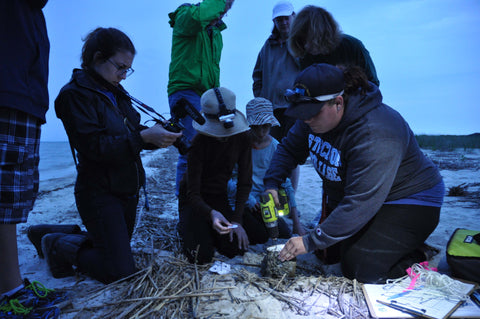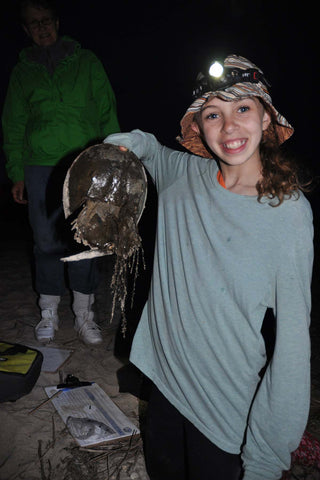Unabridged: a Charlesbridge Children's Book Blog — lisa kahn schnell
Persistence pays off for horseshoe crab visitors<br /><font size=3>by Lisa Kahn Schnell</font> 0
Long sleeves, long pants (with socks pulled up over them), headlamps, and a slathering of bug spray—we were not the typical summertime beach-goers. But we had an important job to do: survey horseshoe crabs!
From the bay-side coast of New Jersey near Cape May, we watched the sun set. Quinn, our leader from the American Littoral Society (ALS), waded into the gentle surf and picked up a wiggly horseshoe crab. Every leg flailed and the book gills fluttered as she talked about horseshoe crab basics. Some of the volunteers examined horseshoe crabs, too.

Quinn talked about restoring local beaches—removing debris and other horseshoe-crab hazards--after Hurricane Sandy hit the coast in October 2012. Horseshoe crabs are generalists. They can eat a variety of food, and they will lay their eggs in sand of varying coarseness. This flexibility is part of what has allowed the species to survive for millions of years! But big rocks or hunks of concrete trap horseshoe crabs and don’t provide a safe place for their eggs to develop. By spring of 2013, the battered beaches were once again ready for the horseshoe crabs, as well as for the shorebirds that rely on their eggs to fuel their journey up to the Arctic.

I had originally been told that we would survey horseshoe crabs that evening. Surveyors place a meter-square plot frame at regular intervals along the shore and count the number of horseshoe crabs they find within the plot frame. Quinn had surveyed the same beach we were on just a week earlier and it had been covered with horseshoe crabs. In one place, they counted 38 in one meter-square frame! The night we were there, so few horseshoe crabs came to shore that she ended up not surveying at all. She had brought along some tags though, and as distant lightning became not-so-distant, we focused on those.
Quinn gave us a quick tagging demonstration.

Then, because I had tagged before (and my family was enthusiastic), we started things off. My older daughter sloshed into the water collecting horseshoe crabs. My mom recorded basic information about each animal.


For a while, I drilled, and my younger daughter—who had just learned to pick up a horseshoe crab that night—inserted the tags. Soon all the volunteers were involved. There was even a videographer making a how-to video about horseshoe crab tagging!
One horseshoe crab we found had a damaged shell. Quinn explained how a horseshoe crab’s blood coagulates around any bacteria that enters a wound and isolates it, allowing the animal to heal itself. That same ability is what makes horseshoe crab blood valuable to humans, too. Scientists use Limulus Amoebocyte Lysate (LAL), which comes only from horseshoe crab blood, to test medical equipment for dangerous bacteria. If the LAL coagulates, it signals a problem.
Other horseshoe crabs we found were crusted with barnacles, slipper shells, and even long tendrils of greenery. There seemed to be entire ecosystems right there on their shells.

Quinn talked about the way scientists can date horseshoe crabs by the age of the animals that live on them. We know that horseshoe crabs mature and stop molting when they are around 10 years old. By dating the ages of the animals that live on mature horseshoe crab shells, scientists estimate that horseshoe crabs can live another 10-15 years once they’ve stopped molting. So, the animals we were looking at were between 10 and 25 years old.
Lightning chased us off the beach soon after we finished the tags Quinn had brought. But nothing could keep us from a quick stop at a nearby ice cream stand to finish off the evening.

A couple nights later, on the night of the new moon, I had a book signing at Bethany Beach Books in Delaware. We didn’t find any horseshoe crabs on the beach there, but visitors at the signing said they’d seen huge numbers of horseshoe crabs nearby, on the bay side. I looked at my family longingly. Tagging had been great, but we didn’t see as many horseshoe crabs as I’d hoped. Maybe it was still possible? It had been a long day, and it was already past everyone’s bedtime. We didn’t even know if we’d see anything.
But my crew was dedicated. As we pulled into the parking lot near a bay-side beach, everything was silent and dark. Ridiculous, I thought. What are we doing here? Then, near the boat launch, there they were!

We walked a bit further to a small sandy beach. More!
That was the sort of moment that inspired me to write my book, High Tide for Horseshoe Crabs, in the first place. This amazing event was happening close to where I’d spent so much time growing up, but for most of my life, I hadn’t known anything about it.
The next day we had lunch with some family friends who now live on the west coast. A couple of the children had read my book, and they were quite smitten with horseshoe crabs. We talked about how horseshoe crabs don’t live on the west coast, but luckily it was just the right time to visit them here. Maybe they’d see some during their visit, I said hopefully.
Back home the next day, I found a photograph in my email in-box. My west-coast friends had gone out to see the horseshoe crabs that evening. They’d even found a tagged crab.

Horseshoe crabs have been on this journey for a long, long time. For some of us, this is only the beginning.
Lisa Kahn Schnell is the author of High Tide for Horseshoe Crabs.

- Stephanie Pessolano
- Tags: author news Cape May high tide for horseshoe crabs horseshoe crabs lisa kahn schnell New Jersey




